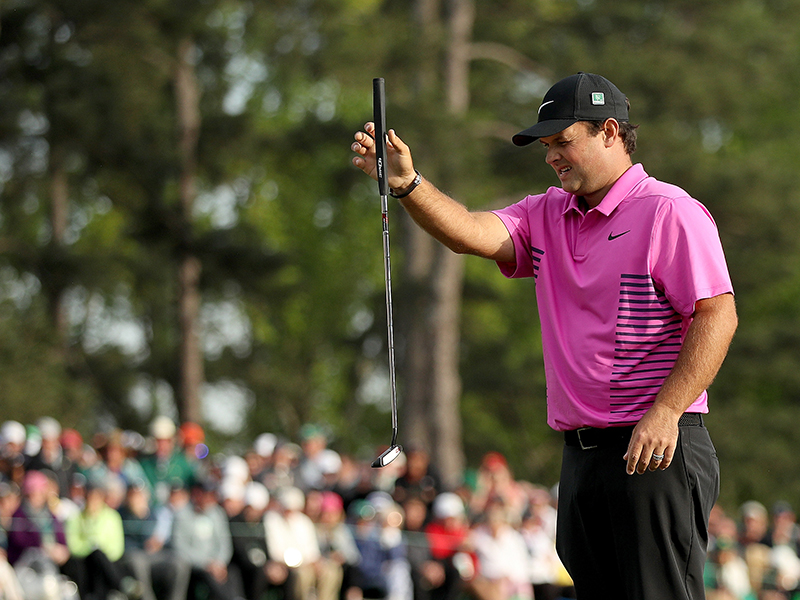How To Plumb Bob A Putt
Learning how to plumb bob a putt could help you identify subtle breaks on the green... but only if done correctly!


For many, reading greens is one of the toughest skills to master and improving in this area can help you to make more birdies and shoot lower scores. Learning how to plumb bob a putt could be the missing link in your arsenal, giving you all the skills and confidence to become a green-reading master.
Masters Champion Patrick Reed famously used the method on his way to collecting a Green Jacket in 2018, and multiple PGA Tour winner Rickie Fowler still utilises the technique.
Understanding the correct way to plumb bob a putt is crucial, as it won't be very helpful if performed incorrectly, so we shared everything you need to know...
What is a plumb bob putt?

Patrick Reed utilising the plumb bob putting technique on his way to winning the 2018 Masters
A plumb bob is a tool that was traditionally used to establish a vertical or 'plumb' line, with the method dating as far back as ancient Egypt. The tool typically used a pointed weight attached to the end of a piece of string, and was used to ensure the walls of buildings were constructed correctly.
In terms of putting, a player will replace the plumb line with their putter, determining whether the break of the green slopes to the left or right.
Check your putter
The first thing you must do before trying the plumb bob putting technique is check the shaft of your putter hangs absolutely vertically when holding it lightly between your thumb and forefinger on the grip.
It likely won’t do that automatically as the shaft will generally not go into the very centre of the head meaning there will be some tilting. Find a known vertical, like the edge of a building, and hold the putter up so you can compare the vertical with the shaft lean.
Subscribe to the Golf Monthly newsletter to stay up to date with all the latest tour news, equipment news, reviews, head-to-heads and buyer’s guides from our team of experienced experts.
Twist the putter round between thumb and forefinger to find the point where the shaft and the chosen vertical are level. Look where the putter head is positioned and remember that.
This is a very important putting tip, as it’s how you must hold your putter each time in order to have a true vertical line when plumb bobbing – It won’t work otherwise.
Get behind it

Rickie Fowler using the plumb bob putting technique
Getting this right could be your ticket to better putting, and it's not that hard to do. Stand about 10 feet or so behind the ball (maybe further back for longer putts), so you are looking directly through the ball to the hole in a straight line. Close one eye and use your dominant eye.
Hold the putter up, as described above between the thumb and forefinger, towards the end of the grip if you can, covering the ball with the shaft. If the shaft also covers the hole, the putt should be straight – the ground you are standing on should be level.
If the shaft appears to the right of the cup, the slope you are on should take the ball from right to left. If it appears to the left of the cup, the slope should take the ball from left to right.
Remember the plumb bob may be a useful guide if you’re not sure on a subtle slope, but it’s not a given, and it also won’t help you determine if the putt is up or downhill.
Take it to the putting green
It's important to practice the plumb bob putting technique before taking it out on the course, and the best way to do that is on the practice green. There are plenty of good putting drills you can try, but when you are reading the line be sure to follow the steps outlined above for how to plumb bob a putt.
An alternative method
It's also possible to use the plumb bob as an indicator of the horizontal contours of the green. Kneel on the ground and have the putter hanging vertically. This will allow you to analyse how the contours of the green cross the shaft. If they do so at the right angles, the green should be flat, with any slopes from left to right or vice versa being easier to make out.
How to plumb bob a putt: The checklist
1) Find a known vertical, and hold the putter up so you can compare it with the shaft lean
2) Twist the putter round between the thumb and forefinger, to find where the shaft and the vertical are level
3) Stand about 10 feet behind the ball
4) Using your dominant eye, hold the putter in plumb bob style, covering the ball
5) If the hole is also covered by the shaft, the putt will be straight. Left or right of the shaft will indicate the break on the green.

Fergus is Golf Monthly's resident expert on the history of the game and has written extensively on that subject. He has also worked with Golf Monthly to produce a podcast series. Called 18 Majors: The Golf History Show it offers new and in-depth perspectives on some of the most important moments in golf's long history. You can find all the details about it here.
He is a golf obsessive and 1-handicapper. Growing up in the North East of Scotland, golf runs through his veins and his passion for the sport was bolstered during his time at St Andrews university studying history. He went on to earn a post graduate diploma from the London School of Journalism. Fergus has worked for Golf Monthly since 2004 and has written two books on the game; "Great Golf Debates" together with Jezz Ellwood of Golf Monthly and the history section of "The Ultimate Golf Book" together with Neil Tappin , also of Golf Monthly.
Fergus once shanked a ball from just over Granny Clark's Wynd on the 18th of the Old Course that struck the St Andrews Golf Club and rebounded into the Valley of Sin, from where he saved par. Who says there's no golfing god?